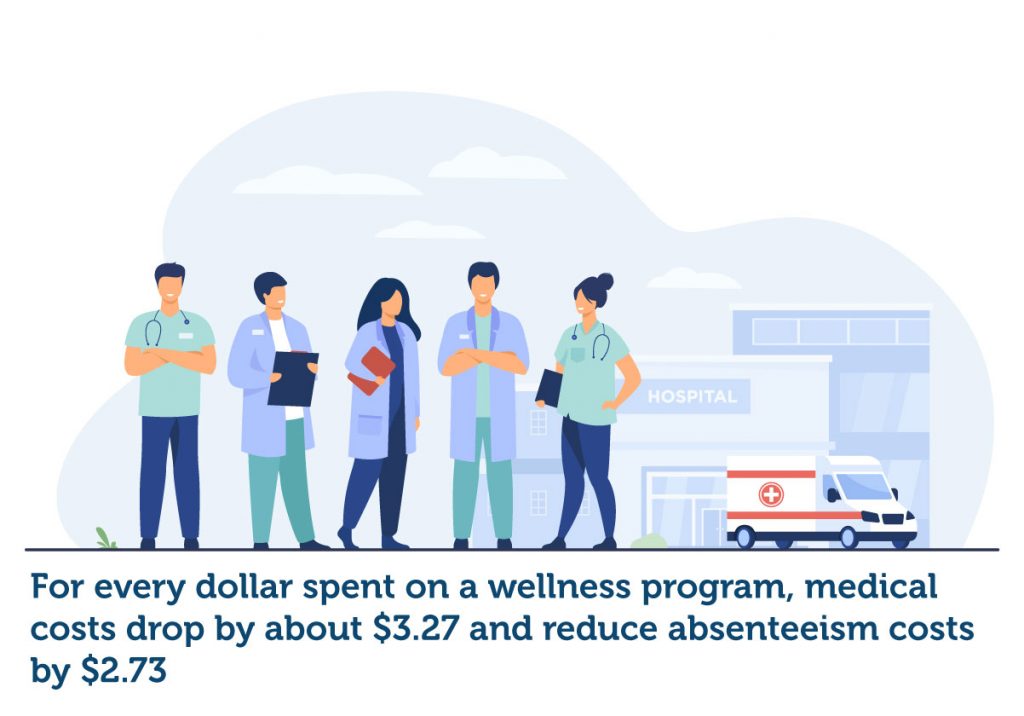
How to be Happy at Work?
If you think a ping-pong table and massage chairs will make employees find long-lasting fulfillment at work, think again.


Founder & Business Expert

CEO & Founder of Breadnbeyond

Co-Founder of Milkwhale

Digital Marketing Manager of Explainerd
Introducing wellness programs to the workplace is becoming a common practice in the U.S., with 84% of large employers providing them as an employee benefit.
However, as the societal landscape evolves, so do the workforce’s needs.
Now, the conversation is shifting towards integrating corporate wellness offerings into a more holistic model explicitly designed for the new rising employee standards.
Considering how much time people spend at work, it makes sense for companies to invest in workplace wellness programs because implementing them is beneficial for both the employees and the employers.
According to a survey by the Integrated Benefits Institute, poor employee health costs employers up to $575 billion annually in addition to the 1.5 billion days of lost productivity.
It follows that having healthy workers can decrease a company’s health spending and boost the workforce’s efficiency. Hence, offering wellness programs that can support the employer’s health plans make it a prudent investment.
In collaboration with experts, this article explores corporate wellness programs and their importance, particularly approaching them holistically.
Ebnu Sudarso, the co-founder of Milkwhale, agrees that a holistic approach is much more beneficial since it touches on all aspects of health. He states, “Today, health spans more than just how you feel physically. How you feel and what you put in your body also matter.
So, approaching wellness holistically in a corporate setting should be considered by every company these days since stress levels run at an all-time high.”
A simple definition of corporate wellness is that it includes every health activity in the workplace that aims to comprehensively support employees’ health, improve their overall well-being, and foster a health-focused company culture.
These activities involve biometric screenings, on-site fitness, stress management, health education, smoking cessation programs, and many more.
The first corporate wellness program prototype was Johnson & Johnson’s Live for Life program in 1979. Through single health initiatives, it aimed to improve managing the three most common risk factors – weight control, nutrition, and stress management.
Nowadays, corporate wellness programs are not just one-time health initiatives but large projects incorporating many benefits designed to nurture a healthy working environment.
In fact, a 2021 Employee Wellness Industry Trends Report shows companies investing more in various corporate wellness offerings to create all-inclusive holistic corporate wellness programs.

A corporate wellness program encapsulates a set of benefits the company provides its employees to help them maintain and boost overall well-being. The goal is to empower and support workers in their pursuit of good health and to facilitate a better working environment.
However, corporate wellness programs are not only important to employers. As the digital marketing manager of Explainerd, Natasha Rei, says, “Corporate wellness is one essential benefit many employees are looking for when they are considering new employment.
Holistic wellness is an important factor to consider when developing a corporate wellness program. It takes into account the whole person, not just their physical health. It also includes their mental and emotional well-being.
Regarding wellness, corporations have a responsibility to their employees to offer comprehensive programs that support all aspects of health and well-being. A holistic approach to corporate wellness provides a more well-rounded program that can significantly impact employee health.”
The earliest roots of wellness in the workplace date back to the 1800s. In 1879, the Pullman Company created an athletic association in their company town. Other companies also offered employee recreational initiatives.
However, the first milestone towards workplace wellness programs emphasizing health promotion was the introduction of employee assistance programs in the 1950s. When they first appeared, they focused only on alcoholism and mental health initiatives.
Yet, true wellness programs gained the most ground in the 1970s as the world was dealing with massive inflation, but it became the employers’ responsibility to bear the employees’ health costs.
Primarily motivated by cost containment, companies turned to wellness programs to reduce healthcare claims and workers’ compensation cases.
Today, wellness programs are taking on a more holistic approach, with offerings focusing on every aspect of well-being. Now, companies are even more aware of the value of wellness, that 81% of large companies and 53% of small businesses provide corporate wellness programs.

The impact of wellness programs in the workplace is frequently researched, and the positive findings are promising.
For one, the RAND Workplace Wellness Programs Study utilized four streams of data collection and analysis and five existing wellness programs case studies to evaluate their efficiency.
During their research, the authors identified that over half of the employers with 50 or more employees implement holistic wellness programs as a long-term strategy to reduce health costs.
Besides being beneficial for the organizations, the study also found that the programs’ interventions promoting lifestyle management reduce risk factors and encourage healthy behaviors.
Hence, it confirms that wellness programs can improve employees’ overall health and well-being.
Additionally, a study by John C White, Stephen Hartley, and Ronald J Ozminkowski published in the Journal of Occupational and Environmental Medicine, “Association Between Corporate Wellness Program Participation and Changes in Health Risks,” collected data from almost 200,000 records of high-risk participants in wellness programs to evaluate the variations of seven health risks (blood pressure, body weight, cholesterol level, nutrition, physical inactivity, stress, and tobacco use).
The results show that five of the seven health risks were reduced among workers after only one year of participating in a coaching program.
The odds of reducing risks increased as employees participated in multiple wellness activities. Moreover, the study also found that the improved risk levels were more significant than the worsened ones.
Andre Oentoro, CEO & Founder of Breadnbeyond, agrees that




Most often, wellness is associated with physical well-being. In actuality, wellness is a holistic embedding of physical, mental, emotional, and spiritual welfare.
1) Physical
Physical health and fitness are inevitably part of the overall person’s wellness.
However, physical wellness is not only about being fit. It encompasses the health of the digestive, circulatory, and musculoskeletal systems.
It is the most straightforward dimension to promote in wellness programs, including gym networks, sleep coaching, or nutrition education.
2) Emotional
Emotional health refers to a person’s ability to deal with their emotions and adequately express them. It’s a concept closely related to mental health since it embodies all aspects of one’s well-being, shaping the way people think, feel, and act.
Supporting mental health in the workplace is vital, and it can be done through various behavioral health and mental initiatives, like mindfulness and meditation classes.
3) Social
Social wellness is critical for people’s aptitude to create meaningful social relationships. It helps create a support network vital for a person’s ability to perform their social roles.
Encouraging employee collaboration and organizing team-building activities to support relationships between colleagues is an excellent way to foster employees’ social wellness.
4) Spiritual
Finding meaning and purpose in life helps people feel at peace and in harmony. Spirituality can be represented in many ways, and each person’s journey is individual and unique. Being in good spiritual health means knowing what resources to use to cope with whatever life has to offer each day.
It is challenging to address spirituality in the workplace, but offerings like volunteering programs or trips in nature can raise awareness of the importance of this dimension.

5) Environmental
The environmental dimension of wellness encourages people to take care of their surroundings and protect the environment. It promotes environmental consciousness and raises awareness of the importance of looking after planet Earth.
Companies can play their part in their employees’ environmental wellness by promoting sustainable living practices and implementing actions in their control, such as making the workplace environmentally friendly.
6) Intellectual
An intellectually healthy person continues developing throughout their whole life. People who address their intellectual health often participate in scholastic and cultural activities. They like keeping an open mind and constantly expanding their knowledge and skills.
Employers can promote their workers’ intellectual wellness through learning and development opportunities, mentorship programs, or career counseling.
7 ) Financial
One of the biggest causes of stress and anxiety is dealing with money. A financially savvy person knows how to manage their expenses successfully. Additionally, they are prudent about how to spend and save their finances. To be able to develop these skills, employees must learn financial literacy.
Financial benefits that promote financial literacy can help workers save for the future.
8) Occupational
Occupational wellness refers to a person’s satisfaction with their work.
Individuals on the positive spectrum of this dimension enjoy their work endeavors and appreciate their contributions. Achieving a healthy work-life balance promotes the importance of this wellness dimension.
Since it influences almost all other health dimensions, initiatives that promote occupational wellness fall under the umbrella of wellness programs.

With the help of scientific evidence and expert opinions from leaders, the “From Evidence to Practice: Workplace Wellness that Works” report states that wellness programs should interlace health promotions with the company’s goals and objectives to create a culture of health.
Programs tailored to meet the employees’ specific needs and provide opportunities for engagement successfully elevate the workforce’s overall health and well-being. Additionally, it found that employees in good health are happier and, therefore, more productive at work.
The latest wellness trends show these are the most popular employee wellness programs.
1) Wellness Challenges
Wellness challenges are all about promoting healthy behaviors and habits. They can range from financial or mental to health and fitness challenges, aiming to foster healthy lifestyles.
2) Financial Challenges
The current inflation rates have made it more vital than ever for people to learn how to manage their finances. Seeing that 73% of Americans assign most of their stress to finances, financial challenges can reduce stress and promote financial wellness.
For instance, suppose a worker is trying to save up to pay off their student loans. The company can motivate them by helping them set financial goals and reward them by paying off a certain percentage once they reach their objective.

3) Mental Health Challenges
Mental wellness is an essential aspect of overall welling.
76% of employees believe that workplaces should actively help with mental health. Hence, mental challenges can serve as a great initiative.
These can include options such as challenging employees to participate in meditation or yoga, which positively impact mental well-being.
4) Health & Fitness Challenges
With workers spending 90% of the time sitting behind a desk for eight hours, health and physical well-being can suffer greatly.
For instance, some companies promote fitness challenges that offer cash incentives if employees participate in a fitness program to encourage them to be fit.
Another great example is a weight management program which can be quite beneficial in today’s working environment.
Gisera Matanda, Founder & Business Expert, offers insight into the advantages of providing a weight loss program.
“Since its introduction, we’ve managed to recruit 68% of our employees into the program, increasing monthly. Many employees feel more energetic when they sit down to handle their job after a virtual group workout.
Others have also given testimonials on how the program has enabled them to shed a few pounds.”
5) EAP: Employee Assistance Programs
Wellness doesn’t only mean maintaining a healthy body but also a healthy mind. Companies now realize that employee assistance shouldn’t end once they leave work. In fact, some workers might require additional support outside the office.
Employee assistance programs can provide necessary help for various issues, such as substance abuse, anxiety, or depression. Such offerings foster supportive company culture and boost employee satisfaction with the organization.

6) Longer & Healthier Lunch
Since the average lunch break in the U.S. is 35 minutes, many employees feel they don’t have time to eat anything other than fast food. Having longer lunch breaks and offering healthy meals and snacks can benefit everyone in the workplace.
It promotes healthy eating, thus fostering healthy behaviors and lifestyles.
Additionally, providing a space to enjoy your food, like a cafeteria, encourages interaction between colleagues within a company.
7) Flexible Working Arrangements
The pandemic has increased awareness of the cost-effectiveness of flexible working schedules. As a matter of fact, many new startups and companies are taking advantage of this, going as far as introducing a four-day workweek.
This is because employees no longer need to be in the office at arranged hours every day to be productive. In fact, letting workers design their working schedule around their needs helps 43% of employees be more productive.
8) Parent Coaching
It is hard being a parent and even harder being one who works.
Parents often need assistance to achieve that work-life balance that will leave them content with their work and home lives. According to a study by Kansas State University, employees who are more engaged at work have a happier home life. Thus, providing parenting programs can help them achieve that positive relationship with their work and families.
It’s no surprise that there is merit in companies caring for and focusing on their employees’ wellness. The following studies show why it is beneficial to have a corporate wellness program.
Research shows that wellness programs can help companies save on healthcare costs. According to a meta-analysis by Katherine Baicker, David Cutler, and Zirui Song published in Health Affairs, “Workplace wellness programs can generate savings,” for every dollar spent on a wellness program, medical costs drop by about $3.27.
This analysis also discovered that wellness programs reduce absenteeism costs by $2.73 for every dollar spent. Not only do they reduce the cost, but employees in good health with healthy behaviors have lower absenteeism rates.

Moreover, since presenteeism due to poor employee health is at least two to three times greater than direct health care expenses, it is clear that healthy workers are more productive.
Andre Oentoro mentions yet another benefit of wellness programs. He says, “Another benefit to corporate wellness is improved morale. Employees who feel their employer is interested in their overall health and well-being are more likely to be motivated to do their best work. This can lead to increased job satisfaction and loyalty to the organization.”
In addition, a study by A. Benavides, and Haillee David, published in SAGE Journals, “LocaLocal Government Wellness Programs: A Viable Option to Decrease Healthcare Costs and Improve Productivity,” found that when participating in a wellness program, 67% of workers felt motivated, and 65% felt they could work more than before.
Moreover, a UC Riverside study saw a 5% increase in the average worker productivity, which amounts to an additional productive day each month.
Natasha Rei agrees that “There are many benefits to implementing a holistic approach to corporate wellness, including:
According to the CDC, six in ten American adults have at least one chronic disease, and four in ten have more. Chronic disease expenditure drives up to 90% of the total $4.1 trillion annual health care costs.
Thus, it is safe to say that employees must promote disease management with appropriate wellness offerings. Managing a disease is not easy, but having support to improve one’s lifestyle and live a healthier and happier life can go a long way.
Disease management benefits can include on-site medical checks, diabetes programs, telemedicine, or health education services to help workers learn how and what lifestyle changes to make to have a more comfortable life, especially at work.
Disease management and wellness offerings can also hinder chronic diseases from progressing into more severe states. For instance, educational programs teach individuals to self-monitor and identify any irregularities. Additionally, fitness or other physical activity programs can significantly lower the mortality risk for various chronic conditions. On top of that, regular screenings help track the disease’s progress and prevent further complications.

According to the U.S. Department of Health and Human Services (HHS), wellness literacy is “the degree to which individuals have the capacity to obtain, process, and understand basic health information needed to make appropriate health decisions.”
Therefore, the need for people to understand how they can improve their overall health and well-being is vital in their journey to achieve high levels of happiness.
Corporate wellness programs can help by offering health education programs that teach employees to change their lifestyles to incorporate healthier behaviors.
Considering all this, what does a holistic approach to corporate wellness offerings entail?
As Ebnu Sudarso says, “Traditional corporate wellness usually focuses on physical health and fitness. Although these two play prominent roles in one’s health, it overlooks other factors that may affect an employee’s overall health, such as mental well-being and stress levels.
A holistic approach is much more beneficial because it touches all aspects of health to help maintain one’s overall health. It focuses on nutrition, mental health, stress management, and physical health.
So, with a holistic approach, you can expect healthier employees and a better working environment, and you won’t have to worry about overlooking anything else.”
Wellness trends show a 53% increase in interest in mental well-being, 51% in financial wellness, and 28% in behavioral health. This proves that employers are becoming more interested in including benefits for all aspects of well-being in the programs.
Other than that, a holistic wellness program offers greater flexibility for the workforce to design their journey to wellness depending on their needs.
Offering a variety of options does not only impact the well-being of the workers but also boosts the employee experience in the workplace.
Another crucial reason for implementing a holistic approach to corporate wellness offerings is the fact that MetLife’s 2022 Employee Benefit Trends Study shows that holistically healthy employees are 74% more satisfied with their job, 51% more likely to stay in the company in 12 months, and 53% more likely to be productive.
Andre Oentoro offers his view on designing compelling corporate wellness offerings with a holistic approach. He states, “A corporate wellness program with a holistic approach can include various components, from on-site fitness facilities and health screenings to educational programs on healthy living and nutrition.
Some companies also offer financial incentives for employees who participate in wellness programs or meet certain health goals.”
However, besides implementing holistic corporate wellness offerings, there are other factors to consider when developing a holistic wellness plan.
1) Foster A Culture of Wellbeing
Wellness programs should align with a company’s culture and goals to achieve maximum results. Thus, a culture of well-being and health should be embedded to promote a more holistic program.
This culture should be leadership-driven and supported by all levels of management. Additionally, it is prudent to be underpinned by two-way communication to discover employees’ needs and challenges in leading healthy lifestyles.
A culture of well-being makes employees healthier and happier, and happy employees are 12% to 20% more productive.
2) Know How to Measure Wellness
Wellness programs have no value unless they are effective. If a program is not set to deal with the wellness challenges of employees, then it will underperform.
Therefore, companies should find a way to measure workplace wellness to design a holistic plan that will incorporate offerings that matter to their workforce.
Apart from measuring wellness, an essential factor of a program’s success is measuring the ROI and VOI to ensure that the offerings have a positive impact and that the company is not losing money.

3) Align the Offerings to Employees’ Needs
According to McLean & Company’s HR Trends Report, organizations that put employees’ needs before theirs during the pandemic experienced 1.5 times higher performance and 1.4 times increased productivity.
To ensure that the initiatives align with employees’ needs, the company must be flexible in implementing corporate wellness offerings.
4) Adopt Technology
As a result of the pandemic, many employees now work from home, and teams are dispersed worldwide. As a result, they cannot use in-person corporate wellness offerings.
Hence, companies should provide wellness programs that can be delivered digitally and virtually.
5) Enable Easy Employee Benefits Access
Even though a wellness program might be perfectly holistically designed, it will not make any headway if employees don’t know how to access its benefits.
Therefore, organizations must adopt different strategies to ensure that their workers know the wellness plans they are offered and understand how to access and utilize them.
Companies are now more aware that wellness stretches beyond being physically fit.
Hence, they are straying away from traditional programs and trying a more holistic approach with their corporate wellness offerings.
Adopting a holistic strategy fosters a culture of well-being in the workplace and supports all dimensions of wellness that affect each person.
Disclosure: Some of the products featured in this blog post may come from our partners who compensate us. This might influence the selection of products we feature and their placement and presentation on the page. However, it does not impact our evaluations; our opinions are our own. The information provided in this post is for general informational purposes only.
Browse our curated list of vendors to find the best solution for your needs.
Subscribe to our newsletter for the latest trends, expert tips, and workplace insights!

If you think a ping-pong table and massage chairs will make employees find long-lasting fulfillment at work, think again.

How do you know if your wellness plan is cost-effective and working out for you? How can you measure employee well-being?

Whether it’s through the use of technology, a focus on mental health, or a greater emphasis on DEI efforts, these workplace wellness trends provide exciting opportunities for businesses.

Discover practical strategies and actionable steps to promote employee well-being and productivity. Create a workplace environment that prioritizes health and fosters a thriving, engaged workforce.
Used by most of the top employee benefits consultants in the US, Shortlister is where you can find, research and select HR and benefits vendors for your clients.
Shortlister helps you reach your ideal prospects. Claim your free account to control your message and receive employer, consultant and health plan leads.